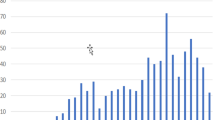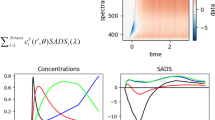Abstract
Forward and back energy transfer between antenna and RC in the photosynthetic apparatus of purple bacteria was studied taking into account the exciton states of the antenna. The exciton states were calculated for core antenna configuration in the form of a circular aggregate of N identical BChl molecules with the CN-symmetry. The influence of pigment inhomogeneity on the proposed exciton description of the antenna and its interaction with RC was investigated. The ratio between the rate constants of forward and back energy transfer between the exciton levels of the antenna and RC was obtained as a function of the temperature, the number of antenna BChls and the antenna exciton level position with respect to BChl special pair level of RC. A versatile analytical expression for this ratio which is independent of the BChl special pair level position and its dipole orientation was derived. The proposed model results in an irreversible excitation trapping by RC even at room temperature.
Similar content being viewed by others
Abbreviations
- RC:
-
reaction center
- BChl:
-
bacteriochlorophyll
- ps:
-
picosecond
References
Abdourakhmanov IA, Danielius R and Razjivin AP (1989) Efficiency of excitation trapping by reaction centres of complex B890 from Chromatium minutissimum. FEBS Lett 245: 47–50.
Bergstrom H, Westerhuis WHJ, Sundstrom V, VanGrondelle R, Niederman RA and Gillbro T (1988) Energy transfer within the isolated B875 light-harvesting pigment-protein complex of Rhodobacter sphaeroides: at 77K studied by picosecond absorption spectroscopy. FEBS Lett 233: 12–16.
deBoer S, Vink KJ, and Wiersma DA (1987) Optical dynamics of condensed molecular aggregates: accumulated photon-echo and hole-burning study of the J-acrgregate. Chem Phys Lett 137: 99–106.
Borisov A Yu, Gadonas RA, Danielius RV, Piskarskas AS and Razjivin AP (1982) Minor component B-905 of light-harvesting antenna in Rhodospirillum rubrum chromatophores and the mechanism of singlet-singlet annihilation as studied by difference selective picosecond spectroscopy. FEBS Lett 138: 25–28.
Danielius RV, Mineyev AP and Razjivin AP (1989) The cooperativity phenomena in a pigment-protein complex of light-harvesting antenna revealed by picosecond absorbance difference spectroscopy. FEBS Lett 250: 183–186.
Davydov AS (1971) Theory of Molecular Excitons, 262 pp, New York: Plenum Press.
Hunter CN, Bergstrom H, VanGrondelle R and Sundstrom V (1990) Energy transfer dynamics in three light-harvesting mutants of Rhodobacter sphaeroides: a picosecond spectroscopy study. Biochemistry 29: 3203–3207.
Kenkre VM (1978) Model for trapping rate for sensitized fluorescence in molecular crystals. Phys Stat Sol (b) 89: 651–654.
Knapp EW (1984) Lineshapes of molecular aggregates. Exchange narrowing and intersite correlation. Chem Phys 85: 73–82.
Li P, Champion PM. (1994) Investigations of the thermal response of laser excited biomolecules. Biophys. J. 66: 430–436.
Novoderezhkin VI and Razjivin AP (1993a) Exciton interactions and their influence on picosecond absorbance difference spectra of light-harvesting antenna of purple bacteria. In: Korppi-Tommola J (ed) Laser Spectroscopy of Biomolecules (Proc. SPIE Vol. 1921), pp 102–106.
Novoderezhkin VI and Razjivin AP (1993b) Excitonic interactions in the light-harvesting antenna or photosynthetic purple bacteria and their influence on picosecond absorbance difference spectra. FEBS Lett 330: 5–7.
Nuijs AM, VanGrondelle R, Joppe HLP, VanBochove AC and Duysens LNM (1985) Singlet and triplet excited carotenoid and antenna bacteriochlorophyll of the photosynthetic purple bacterium Rhodospirillum rubrum as studied by picosecond absorbance difference spectroscopy. Biochim Biophys Acta 810: 94–105.
Otte SCM, Kleinherenbrink FAM and Amesz J (1993) Energy transfer between the reaction center and the antenna in purple bacteria. Biochim Biophys Acta 1143: 84–90.
Pearlstein RM and Zuber H (1985) Exciton states and energy transfer in bacterial membranes: The rule of pigment-protein cyclic unit structures. In: Michel-Beyerle ME (ed) Antennas and Reaction Centers of Photosynthetic Bacteria, pp 53–61. Berlin: Springer-Verlag.
Pullerits T and Freiberg A (1991) Picosecond fluorescence of simple photosynthetic membranes: evidence of spectral inhomogeneity, and directed energy transfer. Chem Phys 149: 409–418.
Pullerits T, Vischer KJ, Hess S, Sundstrom V, Freiberg A, Timpmann K and VanGrondelle R (1994) Energy transfer in the inhomogeneously broadened core antenna of purple bacteria: A simultaneous fit of low-intensity picosecond absorption and fluorescence kinetics. Biophys J 66: 236–248.
Razjivin AP, Danielius RV, Gadonas RA, Borisov A Yu and Piskarskas AS (1982) The study of excitation transfer between light-harvesting antenna and reaction center in chromatophores from purple bacterium Rhodospirillum rubrum by selective picosecond spectroscopy. FEBS Lett 143: 40–44.
Reddy NRS, Picorel R and Small GJ (1992) B896 and B870 components of the Rhodobacter sphaeroides antenna: A hole burning study. J Phys Chem 96: 6458–6464.
Spano FC, Kuklinski JR and Mukamel S (1990) Temperature-dependent superradiant decay of excitons in small aggregates. Phys Rev Lett 65: 211–214.
Sundstrom V, VanGrondelle R, Bergstrom H, Akesson E and Gillbro T (1986) Excitation energy transport in the bacteriochlorophyll antenna systems of Rhodospirillum rubrum and Rhodobacter sphaeroides, studied by low-intensity picosecond absorption spectroscopy. Biochim Biophys Acta 851: 431–446.
Timpmann K, Freiberg A and Godik VI (1991) Picosecond kinetics of light excitations in photosynthetic purple bacteria in the temperature range of 300–4K. Chem Phys Lett 182: 617–622.
Timpmann K, Zhang FG, Freiberg A and Sundstrom V (1993) Detrapping of excitation energy from the reaction center in the photosynthetic purple bacterium Rhodospirillum rubrum. Biochim Biophys Acta 1183: 185–193.
VanGrondelle R, Bergstrom H, Sundstrom V, VanDorssen RJ, Vos M and Hunter CN (1988) Excitation energy transfer in the light-harvesting antenna of photosynthetic purple bacteria: the rule of the long-wavelength absorbing pigment B896. In: Scheer H and Schneider S (eds) Photosynthetic Light-Harvesting Systems, pp 519–530, Berlin, New York: Walter de Gruyter & Co.
VanGrondelle R, VanMourik F, Visschers RW, Somsen OJG and Valkunas L (1992) The bacterial photosynthetic light-harvesting antenna aggregation state, spectroscopy and excitation energy transfer. In: Research in Photosynthesis, Vol 1, pp 9–16. Kluwer Academic Publishers, Dordrecht, The Netherlands.
VanMourik F, Visscher RW and VanGrondelle R (1993) Spectralinhomogeneity of the light-harvesting antenna of Rhodospirillum rubrum probed by triplet-minus-singlet spectroscopy and singlet-triplet annihilation at low temperatures. Photochem Photobiol 57: 19–23.
Visschers RW, VanMourik F, Monshouwer R, VanGrondelle R (1993) Inhomogeneous spectral broadening of the B820 subunit from LH1. Biochim Biophys Acta 1141: 238–244.
Zuber H (1985) Structure and function of light-harvesting complexes and their polypeptides. Photochem Photobiol 42: 821–844.
Zuber H (1987) The structure of light-harvesting pigment-protein complexes. In: Barber J (ed) The Light Reactions, pp 197–259, Amsterdam: Elsevier Science Publishers
Author information
Authors and Affiliations
Rights and permissions
About this article
Cite this article
Novoderezhkin, V.I., Razjivin, A.P. Exciton states of the antenna and energy trapping by the reaction center. Photosynth Res 42, 9–15 (1994). https://doi.org/10.1007/BF00019053
Received:
Accepted:
Issue Date:
DOI: https://doi.org/10.1007/BF00019053




